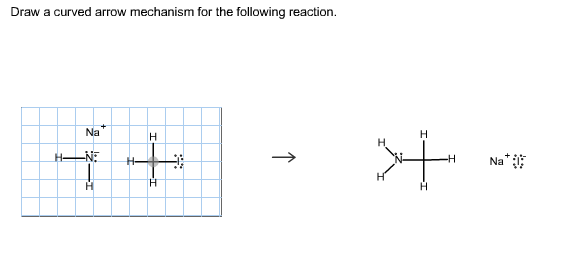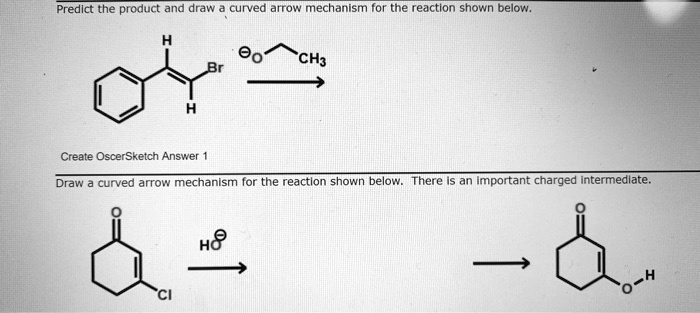Using the drawing window draw a structural formula or formulas for the compound s or ions formed by this mechanism. Our tutors have indicated that to solve this problem you will need to apply the Reaction Mechanism concept.

Draw A Curved Arrow Mechanism For The Following Reaction Na H H N Na H H Homeworklib
You only need to explain the products pictured in the scheme.

. This is shown by drawing two curved arrows. Electron flow is indicated with curved arrows. You dont need to worry about stereochemistry for these problems.
When the Show Problem button is pressed a curved arrow mechanism will be shown below. The overall charge on the left-hand side. Note that below the usual curved arrow icon is another icon for drawing single-headed fishhook arrows for drawing free-radical reactions with the movement of single electrons.
Starting from the base and ending at the acid. The reaction shown below yields one major addition product as a racemic mixture For the mechanism step below draw curved arrows to show electron reorganization. Curved arrows in resonance structures.
Everything You Need to Know About Mechanisms A The Correct Use of Arrows to Indicate Electron Movement The ability to write an organic reaction mechanism properly is key to success in organic chemistry classes. Understanding the mechanisms of organic reactions is key to understanding Organic. There are two main areas where curved arrows are used.
Solved Given The Single Step Reaction Shown Draw The Curved Arrow Mechanism Add A Curved Arrow Select Draw Rings More Erase Chg Hzc Br H C Ch 3 Chg. Draw a curved arrow mechanism for the reaction shown. 2 Determine the major functional group present in the nucleophile and electrophile.
If more than one species is formed in the reaction draw them all using the New button to start a second component. One arrow starts from each radical and both arrows end where the bond is formed. Draw the intermediates major products including stereochemistry for each.
Given The Following Single Step Reaction Draw The Curved Arrow Mechanism Add Curved Arrows Na H3 H3cch2 Homeworklib. This is shown by drawing curved arrow 1 from the nitrogen lone pair to the carbon. Use curved arrows to show the mechanism of the propagation step below.
Draw the products of the reaction shown. 3 The acid-base reaction should be charged balanced. Select the Curved Arrow Tool.
Select Draw Rings More Erase C H 1 Na N H H Na N CH 1 H H N. This reaction starts with the ammonia nitrogen forming a σ bond with the carbon at the end of the chain. Double-headed curved arrows show that two electrons at the start of the arrow move to the position at the end of the arrow.
Form a covalent bond with another atom which is not a radical breaking a σ or π bond on that atom and putting a new radical on the other end of the broken bond. As carbon can only have a maximum of four bonds another bond must be broken. Additional instructions will be given in the information window.
O Draw the product of the SN2 reaction shown below. Alternatively you can access the tool from the Insert Electron Flow menu. An arrow can start from a lone pair or from a bond σ and π and can end on an atom as a lone pair or a σ bond or on a bond as a π bond.
Select the curved arrow drawing tool from the toolbar. For some of these reactions there may be other possible products that are not shown. Solution for Draw a curved arrow mechanism for the reaction shown.
Up to 256 cash back Draw the complete mechanism for the radical reaction shown. Your mechanism must account for all products shown. Make the ends of your arrows specify the origin and destination of reorganizing electrons.
Noting the curved arrows draw all the products organic and inorganic of the following reaction. Organic chemists use a technique called arrow pushing to depict the flow or movement of electrons during chemical reactions. The big difference between these two is that in resonance structures the connectivity of atoms stays the same.
--- H H N Na. The first one is their use is resonance structures and the second is their use in demonstrating the mechanisms of organic reaction. How to Draw a Curved Arrow Mechanism in Organic Chemistryorganicchemistry reactionmechanism curvedarrowCurved arrows used by organic chemists to show rea.
--- H H N Na. CH3 H2SO4 You do not have to consider stereochemistry. The mechanism of an organic reaction is the sequence of steps in the reaction including details of what bonds are formed andor broken in each step.
Given the following single-step reaction draw the curved-arrow mechanism. Lone pairs and bonds are both. When the Show Problem button is pressed a curved arrow mechanism will be shown below.
Select a problem from the list on the right. This is because there is. Draw a curved arrow mechanism for the reaction shown.
The value of Δ H for the reaction is 75 k J m o l and the value of Δ S is 54 J K m o l. Select Draw Rings More Erase C H 1 Na N H H Na N CH 1 H H N. There will be a total of three curved arrows one of which is drawn for you.
It may help if you take the following steps. Select Draw Rings More Erase H Na H. MaryAnn Robak Chem 3B Sp21 Problem Set L page 119 Draw a curved arrow mechanism for each of the reactions shown below.
This means that resonance structures. Draw the product of the following reaction by following the curved arrows. One bond formed base grabbing the proton one bond broken the acid releasing the proton 2 The arrows should flow in the same direction.
Draw a complete step-wise curved arrow mechanism for each reaction shown below. 1 Find the nucleophile and the electrophile. Drawing Curved Arrows for Polar Reactions.
Draw the curly or curved arrows that organic chemists use to depict bond forming and breaking processes. Using the drawing window draw a structural formula or formulas for the compounds or ions formed by this mechanism. 1 There should be two curved arrows.

Solved Draw A Curved Arrow Mechanism For The Following Re Na Chegg Com

Organic Chemistry 331 Sapling Learning Ch 9 Flashcards Quizlet

Solved Draw A Curved Arrow Mechanism For The Reaction Shown Chegg Com

Solved Draw A Curved Arrow Mechanism For The Following Chegg Com

Solved Given The Single Step Reaction Shown Draw The Curved Arrow Mechanism Add A Curved Arrow Select Draw Rings More Erase Chg Hzc Br H C Ch 3 Chg

Given The Following Single Step Reaction Draw The Curved Arrow Mechanism Homeworklib

Solved Draw A Curved Arrow Mechanism For The Reaction Shown Chegg Com

Solved Predict The Product And Draw Curved Amow Mechanism Ior The Reaction Shown Below Ch3 Create Oscersketch Answer Draw Curved Arrow Mechanism For The Reactlon Shown Below There Is Important Charged Intermedlate H8
0 comments
Post a Comment